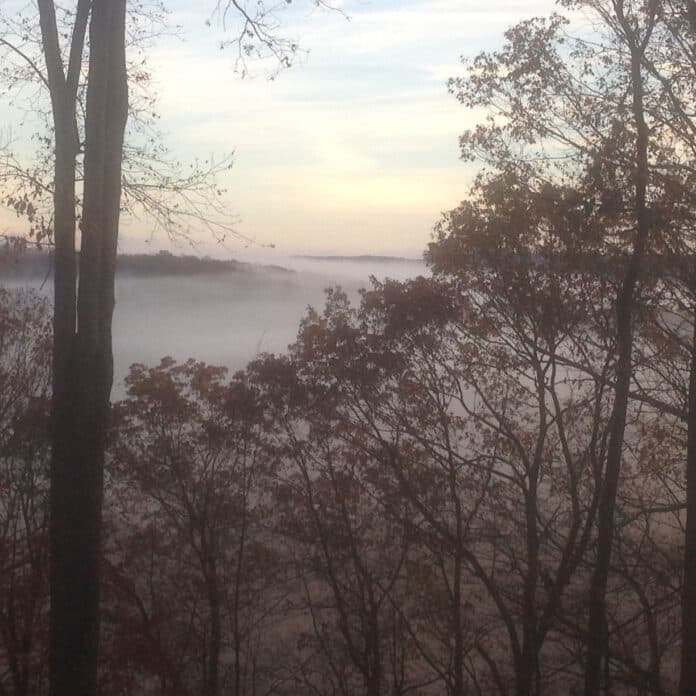By DAVE BOEYINK, guest columnist
Despite unseasonably cool temperatures, spring is coming.
Crocus and daffodils have already brought welcome color to March’s misty mornings. And now native dogwood blossoms are unfurling. I can even see tiny leaves on new spicebush plants.
My wife and I have only a couple acres on Town Hill Road, but tramping through the woods discovering illusive native plants underfoot is a restful pastime.
Unfortunately, the signs of unwelcome visitors are also springing to life. Invasives like multiflora rose, though reduced in number, still have not been rooted out. Autumn olive, already reaching for the sun, can be found all along our road. And just last week, I spotted a stubborn patch of garlic mustard — smaller than last year, but still healthy — down below the deck.

And that’s the message of spring in 2016: If we want to have woods where we can hike without multiflora thorns or to see native wildflowers that are not choked out by autumn olive or garlic mustard, we need to control these invasive plants.
One local organization, the Brown County Native Woodlands Project, has spearheaded the battle against invasives using both eradication and education for more than 10 years. This group has sponsored a number of public projects.
Removing invasives from the ravine by the Brown County Public Library and replanting with natives.
Attacking Japanese stiltgrass clogging the mountain bike trails in the Brown County State Park.
Cutting away invasives like autumn olive and Japanese bush honeysuckle from Van Buren Elementary School.
All these projects are useful. But this small group of 15 to 20 people can’t save the county from its tenacious new tenants. Controlling invasives on public land is vital, but landowners are the only ones who can carry the fight to private property. And believe me, invasives are no respecter of property rights.
Control of invasive species will take the involvement of more Brown Countians, especially those who own a piece of its wooded landscape. The Brown County Native Woodlands Project wants you to join the effort to control invasives by hitting them where it hurts: in your backyard.
Consider this your invitation.
It doesn’t matter if you can’t tell the difference between Asian bush honeysuckle and native bush honeysuckle, or between multiflora rose (invasive) and native roses. Frankly, I’m no expert, either. But here are a few ways we can begin to learn:
Sign up for a free land survey. A representative of the Brown County Native Woodlands Project will walk your land with you and show you what’s native and what’s knotweed. All you need to do is email [email protected] or call 812-988-2211 and arrange for someone to visit your property. Did I mention this was free?
Come to Nature Daze Sept. 10 at Camp Rancho Framasa. The day will be filled with talks and interpretive hikes led by professionals. The entire event is free, including a picnic-style barbecue lunch. Just check out the group’s website (see below) and register beginning in June.
Visit the Brown County Native Woodlands Project website at bcnwp.org. The site has resources to educate you on both invasives and native plants. And be sure to check out the listing of hikes and native plant sales on tap this April.
Controlling invasives requires a long-term commitment. But if you target your efforts, you will see the differences from year to year.
The alternative is to lose the value and beauty of the land you cherish. Living well in Brown County means caring for the natural beauty of the land, a beauty that is slowly being threatened.
You don’t need to be overwhelmed. Start small, like I did, targeting just a few invasive species. My targets? Multiflora rose, autumn olive and garlic mustard.
Walking on our property last summer, I spied a cluster of native trillium plants I had not seen before. That was the same spot where I had pulled out a thick patch of garlic mustard the year before. A few garlic mustard plants survived, but now the native plants have the upper hand.
A small victory. Huge satisfaction.
So join the fight. Brown County needs you. And your woodlands will continue to deliver the beauty and diversity you want.
Dave Boeyink is a retired IU journalism professor. He enjoys walking his aging husky, Kaizer, in Brown County’s woods. Boeyink is education committee chair of the Brown County Native Woodlands Project.





